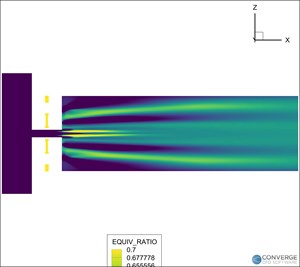Southwest Research Institute designing “innovative” hydrogen combustion systems
(WO) —Southwest Research Institute is designing innovative hydrogen combustion systems for gas turbines used in power generation. The designs prevent flashback, a common concern in hydrogen-fueled combustion systems wherein the flame from the combustor travels into the nozzle, which can result in damaged equipment.

Hydrogen fuel has numerous benefits including the fact that it produces no carbon emissions during the combustion process. However, one of the things that is especially challenging is that it’s highly reactive, which makes it more difficult to work with than natural gas or the liquid fuels that gas turbines typically run on.
“With pure hydrogen fuel, traditional low emissions designs are highly susceptible to a damaging phenomenon known as flashback,” said Griffin Beck, manager of SwRI’s Propulsion and Energy Machinery section. “This occurs when the flame in the combustor flashes back into the nozzle, which can be damaging to the equipment.”
To remedy this, SwRI is exploring novel ways to mix air and hydrogen within the nozzle while avoiding flashback. The designs, which also target very low nitrogen oxide (NOx) emissions, were generated as part of a project supporting the development of a 100% hydrogen-fueled combustion system for an industrial gas turbine.
“One of the reasons hydrogen is such an attractive alternative fuel is that it does not create carbon dioxide emissions, but it does create NOx. However, if the air and hydrogen are mixed efficiently in the nozzle, the NOx emissions are significantly lower,” Beck said.
The nozzles work by mixing air with hydrogen fuel through small, perpendicular pathways. This design allows the air and hydrogen to mix rapidly before being forced out of the nozzle and into the combustor at flow rates that prevent flashback.
“When the right amount of air and hydrogen are mixed very well, the amount of NOx emissions is very low,” Beck said. “Also, the air and hydrogen are forced so quickly out of the nozzle that the flame in the combustor is unable to travel backwards.”
The design and analysis of the nozzles was accomplished by utilizing the extensive experience of staff within the Mechanical Engineering and Powertrain Engineering Divisions at SwRI. Members of the interdisciplinary team relied on computational fluid dynamics as well as machine-learning tools to generate, analyze and optimize the nozzle designs.
“To solve this problem, we utilized the Institute’s computational and analytical tools to design and model this technology,” Beck said. “The actual simulations we’ve been doing are extremely computationally intensive, requiring entire sections of our high-performance computing cluster for days to solve these computing problems. It’s allowed our engineers to take some unique ideas and apply them to this challenge.”


